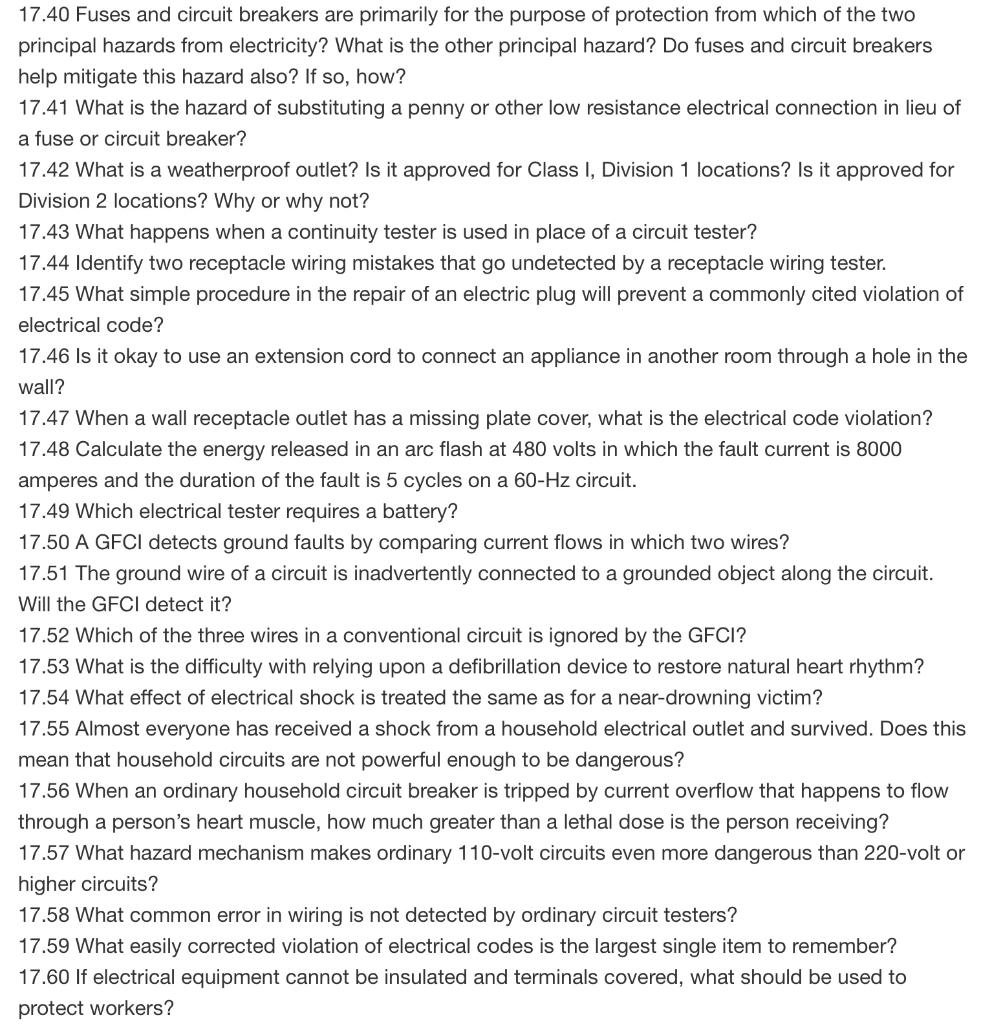Answer ALL questions 17.40 through 17.63


17.40 Fuses and circuit breakers are primarily for the purpose of protection from which of the two principal hazards from electricity? What is the other principal hazard? Do fuses and circuit breakers help mitigate this hazard also? If so, how? 17.41 What is the hazard of substituting a penny or other low resistance electrical connection in lieu of a fuse or circuit breaker? 17.42 What is a weatherproof outlet? Is it approved for Class I, Division 1 locations? Is it approved for Division 2 locations? Why or why not? 17.43 What happens when a continuity tester is used in place of a circuit tester? 17.44 Identify two receptacle wiring mistakes that go undetected by a receptacle wiring tester. 17.45 What simple procedure in the repair of an electric plug will prevent a commonly cited violation of electrical code? 17.46 Is it okay to use an extension cord to connect an appliance in another room through a hole in the wall? 17.47 When a wall receptacle outlet has a missing plate cover, what is the electrical code violation? 17.48 Calculate the energy released in an arc flash at 480 volts in which the fault current is 8000 amperes and the duration of the fault is 5 cycles on a 60Hz circuit. 17.49 Which electrical tester requires a battery? 17.50A GFCl detects ground faults by comparing current flows in which two wires? 17.51 The ground wire of a circuit is inadvertently connected to a grounded object along the circuit. Will the GFCl detect it? 17.52 Which of the three wires in a conventional circuit is ignored by the GFCl? 17.53 What is the difficulty with relying upon a defibrillation device to restore natural heart rhythm? 17.54 What effect of electrical shock is treated the same as for a near-drowning victim? 17.55 Almost everyone has received a shock from a household electrical outlet and survived. Does this mean that household circuits are not powerful enough to be dangerous? 17.56 When an ordinary household circuit breaker is tripped by current overflow that happens to flow through a person's heart muscle, how much greater than a lethal dose is the person receiving? 17.57 What hazard mechanism makes ordinary 110 -volt circuits even more dangerous than 220 -volt or higher circuits? 17.58 What common error in wiring is not detected by ordinary circuit testers? 17.59 What easily corrected violation of electrical codes is the largest single item to remember? 17.60 If electrical equipment cannot be insulated and terminals covered, what should be used to protect workers? 17.61 Design Case Study. In an actual case history of an electrocution fatality, Figure 17.18(a) illustrates the way the chuck key for a hand-held electric drill was conveniently attached to the power cord so that it would always be readily available for operator use in changing bits. The fatality occurred when the twisted wire wore through the cord insulation after continued use. Figure 17.18(b) illustrates a much safer way to connect the chuck key. What other factors probably contributed to this fatality and how could it have been prevented? Suppose that the ground pin had been broken off the plug for this drill. How would this code violation have affected this fatality? (a) FIGURE 17.18 Cause of electrocution fatality: chuck key secured to cord by twisted wire tie. (a) Unsafe, improvised attachment of chuck key. Wire or tape will eventually damage cord insulation. (b) Safer method of attaching chuck key. 17.62 Design Case Study. An architectural design and engineering firm seeks advice regarding federal safety standards for wiring for a new process being set up to manufacture dyestuff. The process uses chlorobenzene and releases ignitable concentrations in the vicinity of the process equipment. Specify the appropriate Class, Division, and Group classification for wiring and electrical equipment located in this area. 17.63 Design Case Study. In the case study of Exercise 17.62 , suppose an alternate supplier of process equipment proposes a completely closed system in which releases would only occur during repair or in event of a leak. Such occurrences arise frequently out of a need to regularly clean the infeed mechanism. Would the closed system have an impact on safety and on the prescribed wiring








